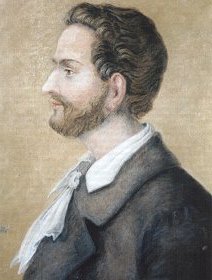- Ludwig Leichhardt
Infobox Person
name = Friedrich Wilhelm Ludwig Leichhardt

image_size = thumb
caption = Portrait of Ludwig Leichhardt
birth_date = birth date|1813|10|23|mf=y
birth_place = Sabrodt, Prussia
death_date = unknown - probably 1848
death_place = presumed to be InlandAustralia
occupation = ExplorerFriedrich Wilhelm Ludwig Leichhardt (
October 23 ,1813 - probably 1848 in Inner Australia) was aPrussia n explorer and naturalist. He was born in Sabrodt, today part ofTauche , Prussia (nowBrandenburg ,Germany ).Biography
Early life
Between 1831 and 1836 Leichhardt studied philosophy, language, and natural sciences at the Universities of
Göttingen andBerlin but never received a university degree. He moved toEngland in 1837 where he continued his study of natural sciences at various places, including theBritish Museum ,London and theJardin des Plantes ,Paris , and undertook field work in severalEurope an countries includingFrance ,Italy andSwitzerland .Explorer
In 1842 Leichhardt voyaged to
Sydney , inAustralia . He led three major expeditions to explore parts of northern and central Australia. The first, mounted as a private expedition, started onOctober 1 ,1844 from Jimbour on theDarling Downs and ended after a nearly 4800 km overland journey inPort Essington onDecember 17 ,1845 . He returned to Sydney by boat to a hero's welcome. The "Journal of an Overland Expedition in Australia, fromMoreton Bay to Port Essington, a Distance of Upwards of 3000 Miles, During the Years 1844-1845" by Leichhardt describes this expodition.The second expedition, now with the assistance of a Government grant and substantial private subscriptions, starting in December 1846, was supposed to take him from the Darling Downs to the west coast of Australia and ultimately to the Swan River and Perth. After covering only 800 km the expedition team was forced to return in June 1847 due to heavy rain, malarial fever and famine. After recovering, Leichhardt spent 6 weeks in 1847 to examine the course of the
Condamine River and the country between the route of another expedition led by Mitchell in 1846 and his own route, covering nearly 1,000 km.In March 1848 he again set out from the Condamine River to reach the Swan River. He was last seen on
April 3 1848 at McPherson's Station, Coogoon on theDarling Downs . His disappearance after moving inland, although investigated by many, remains a mystery. The authentication of Leichhardt's rifle nameplate at Sturt Creek near the Western Australia — Northern Territory border (see below), may shed more light on that mystery.earches for Leichhardt
Four years after Leichhardt's disappearance, the
Government of New South Wales sent out a search expedition underHovendon Hely . The expedition found nothing but a single campsite with a tree marked "L" over "XVA". In 1858, another search expedition was sent out, this time underAugustus Gregory . This expedition found only a couple of trees marked "L". In 1865,Duncan McIntyre was shown a tree marked "L" on theFlinders River near theGulf of Carpentaria . This mark was almost certainly made byWilliam Landsborough ; or if it was made by Leichhardt then it would have been during his 1844 journey toPort Essington . However, McIntyre reported toMelbourne that he had found traces of Leichhardt, and was subsequently appointed leader of a search expedition. This expedition was a complete failure, not even reaching the search area. In 1869, theGovernment of Western Australia heard rumours of a place where the remains of horses and men killed byindigenous Australians could be seen. A search expedition was sent out underJohn Forrest , but nothing was found, and it was decided that the story might refer to the bones ofhorses left for dead at Poison Rock duringRobert Austin 's expedition of 1854.The mystery of Leichhardt's fate remained in the minds of explorers for many years: during
David Carnegie 's 1896 expedition through the Gibson and Great Sandy Deserts, he encountered some indigenous Australians who had amongst their possessions an iron tent peg, the lid of a tin matchbox, and part of the ironwork of a saddle. Carnegie speculated that these were originally from Leichhardt's expedition.In 2006 Australian historians authenticated a tiny brass plate bearing Leichhardt's name, originally discovered by an Aboriginal stockman near Sturt Creek on the Western Australia — Northern Territory border in about 1900. When found, the plate was attached to a partially burnt shotgun slung in a boab tree which was engraved with the initial "L".cite web| url=http://www.theage.com.au/articles/2006/11/23/1163871550048.html| title=Small clue reveals explorer's huge endeavour| publisher=The Age - online| first=| last=|date=September 24, 2006]
Legacy
The
Inner Western Sydney suburb of Leichhardt and the surroundingMunicipality of Leichhardt are named for him, as is the Ipswich suburb of Leichhardt and theLeichhardt Highway inQueensland .Leichhardt's last expedition was the inspiration for the novel 'Voss'by Patrick White.
References
*Cite book | last =Erdos | first =Renee | title =Leichhardt, Friedrich Wilhelm Ludwig (1813 - 1849) | location=Melbourne | publisher =
Australian Dictionary of Biography ,Australian National University | year =1967 | pages =pp. 102–104 | edition =2: 1788-1850 I-Z | url =http://www.adb.online.anu.edu.au/biogs/A020090b.htm | isbn= 0522842364
*Dictionary of Australian Biography |First=Ludwig |Last=Leichhardt |Link=http://gutenberg.net.au/dictbiog/0-dict-biogL.html#leichhardt1External links
*
Project Gutenberg e-text of [http://www.gutenberg.net/etext/5005 Journal of an Overland Expedition in Australia]
*Entry for [http://www.gutenberg.net.au/pages/leichhardt.html Ludwig Leichhardt] in [http://gutenberg.net.au/pgaus.html The Project Gutenberg Library of Australiana]
*
* [http://www.sl.nsw.gov.au/discover_collections/history_nation/exploration/compass/leichhardt.html Ludwig Leichhardt online collection - State Library of NSW]
Wikimedia Foundation. 2010.
